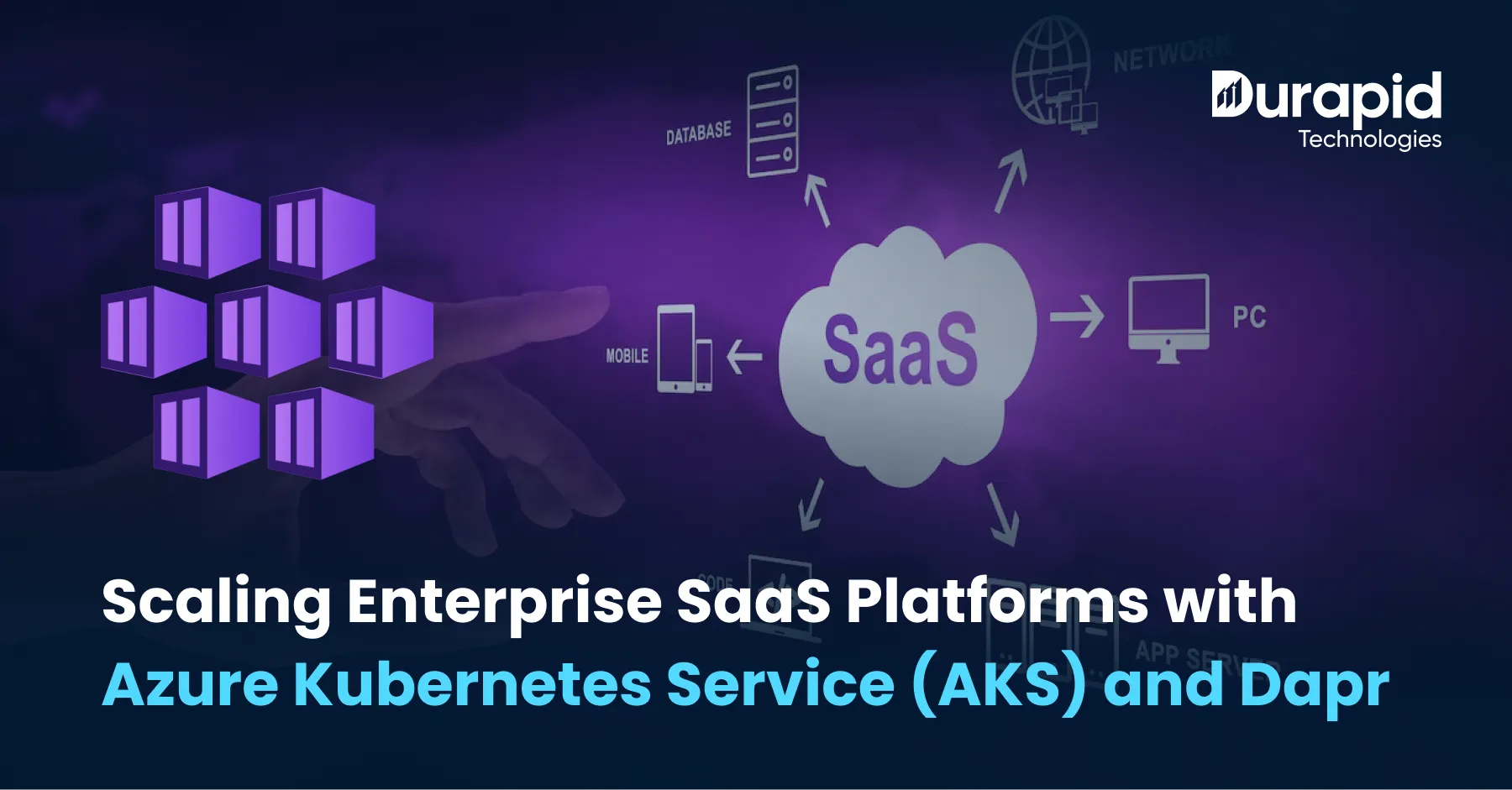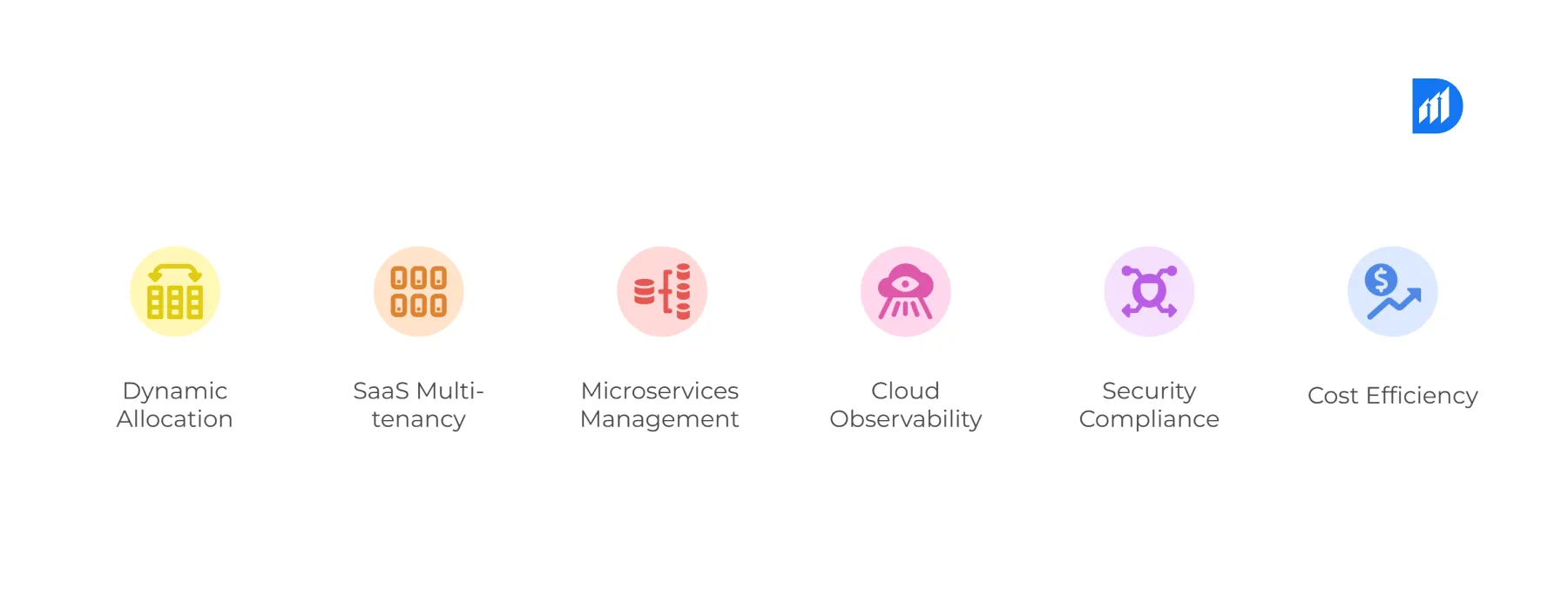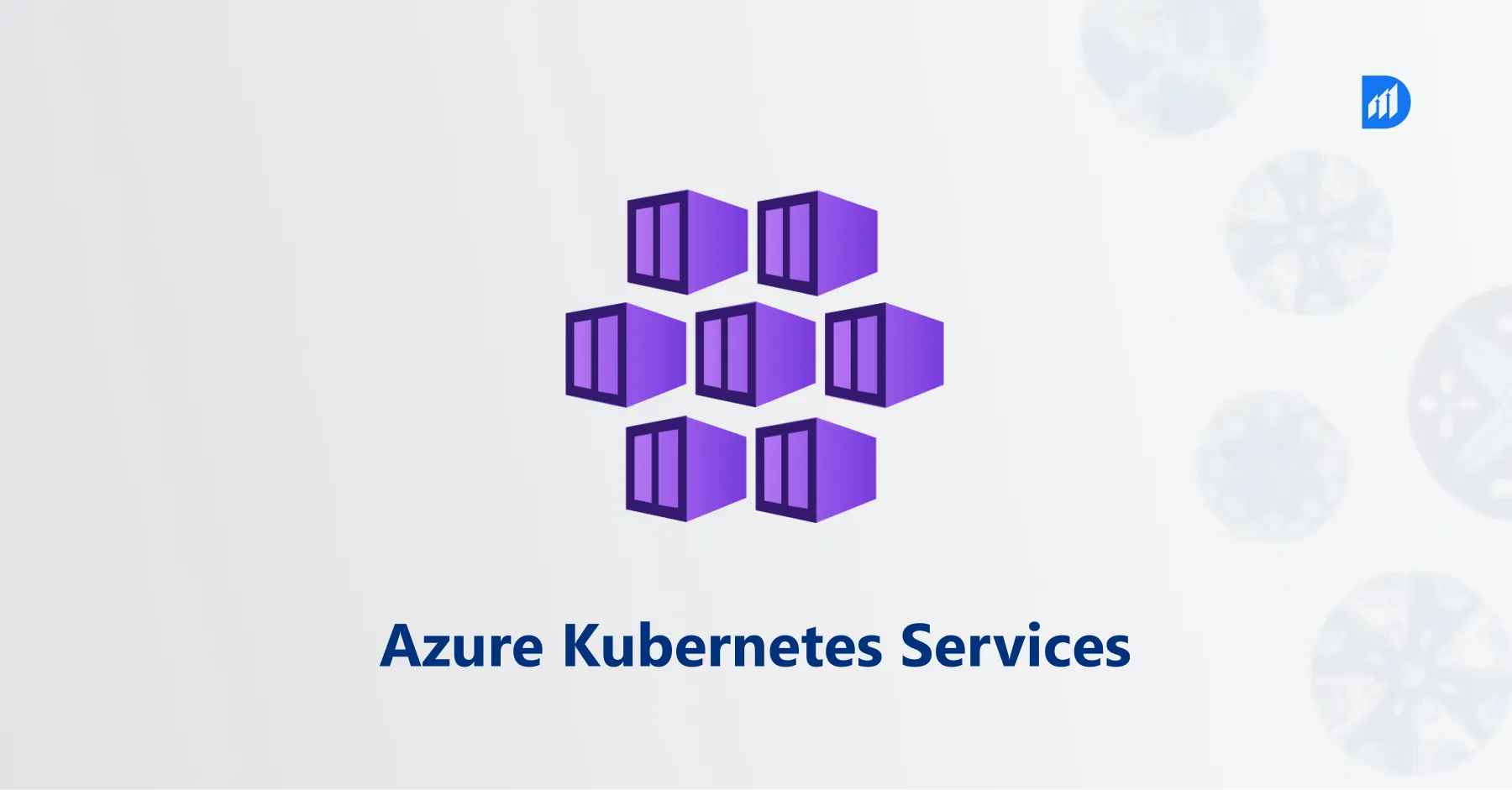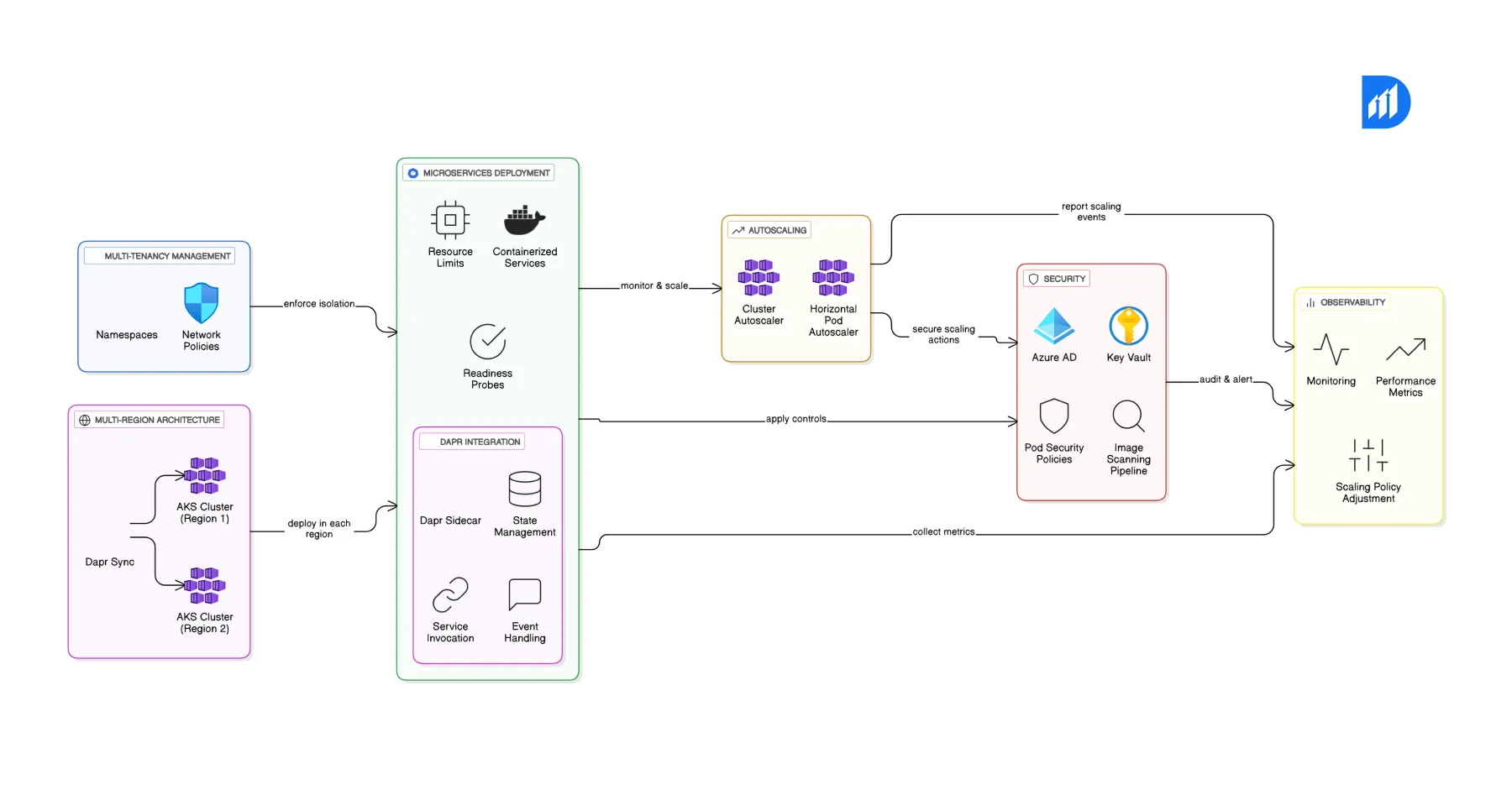Scaling Enterprise SaaS Platforms with Azure Kubernetes Service (AKS) and Dapr

Introduction
Enterprise SaaS platforms are at a crossroads. The pressure to deliver faster, more reliable, and cost-effective solutions has reached a new high. With 73% of organizations accelerating their digital transformation efforts, there’s no room for old-school, monolithic systems that can’t keep up. This is where AKS SaaS scaling steps in as a game-changer. Combining the power of Azure Kubernetes Service with modern distributed runtimes, AKS SaaS scaling is redefining how businesses build and grow scalable SaaS platforms that don’t just meet demands—they anticipate them.
If you’re ready to go beyond the old ways and build SaaS platforms built for today and tomorrow, mastering AKS SaaS scaling is key. This guide breaks down what you need to know: the technical setup, smart strategies for implementation, and practical best practices that lead to real business impact.
Understanding how to leverage AKS and Dapr together is your path to creating SaaS solutions that adapt quickly, perform consistently, and deliver value every step of the way.
The Enterprise SaaS Scaling Challenge
Enterprise SaaS platforms today face demands that go well beyond just handling more users. The modern SaaS landscape requires solutions that can manage millions of users, process enormous data volumes, and maintain near-perfect uptime — all while juggling complex multi-tenant environments across the globe.
Key Challenges for Enterprise SaaS:

- Dynamic resource allocation: Scale resources instantly based on fluctuating demand without manual intervention.
- SaaS multi tenancy model: Support isolated and secure tenant environments across multiple geographic regions.
- Microservices state management: Handle distributed state consistently across services without performance loss.
- Cloud native observability: Implement end-to-end monitoring, tracing, and alerting in a cloud-native way.
- Security and compliance: Ensure enterprise-grade protections across workloads, data, and network traffic.
- Cost efficiency: Achieve high scalability without ballooning cloud costs or compromising performance.
Why Traditional Scaling Approaches Don’t Cut It Anymore
Older methods like vertical scaling or simplistic load balancing hit a wall when SaaS platforms grow. Monoli
thic systems tend to suffer from:
- Limited fault isolation: One component failure can impact the entire system.
- Complex deployments: Updates and feature releases become risky and slow.
- Technology constraints: Difficult to adopt new tools or architectures.
- Resource inefficiency: Over-provisioning wastes cost; under-provisioning hurts performance.
- Slow innovation cycles: Time to market for features extends unnecessarily.
Azure Kubernetes Service: The Core of Enterprise SaaS Scaling

Azure Kubernetes Service (AKS) is designed to address these exact challenges. As a managed Kubernetes platform, AKS delivers robust microservices orchestration that scales horizontally and supports enterprise requirements out of the box.
Why AKS for SaaS Scaling?
- Managed control plane: Azure handles the Kubernetes API, etcd, and scheduler — reducing your operational burden.
- Flexible node pools: Use different VM sizes optimized for your workload needs.
- Integrated security: Pod security policies, network policies, and Azure Active Directory integration keep your environment secure.
- Persistent storage: Seamless integration with Azure Disk, Azure Files, and other persistent volumes.
- Autoscaling: Kubernetes autoscaling responds to CPU, memory, and custom metrics to optimize resource use dynamically.
AKS Technical Highlights
| Component | Details |
| Node VM Sizes | Standard_D4s_v3 to Standard_E64s_v3 for production |
| Max Nodes per Cluster | Up to 5,000 nodes |
| Max Pods per Node | 250 pods (with Azure CNI networking) |
| Autoscaling Triggers | CPU > 70%, Memory > 80% |
| Networking | Supports Azure CNI or Calico for network policies |
| Storage Options | Premium SSD (up to 32TB, 20K IOPS), Ultra Disk (64TB, 160K IOPS), Azure Files for multi-pod access |
Implementing Best Practices for AKS SaaS Scaling
Scaling on AKS successfully requires attention to security, reliability, and operational efficiency. Here’s how to build enterprise-grade SaaS solutions leveraging AKS and Dapr:
Azure Kubernetes Service Security Best Practices
- Network segmentation: Isolate tenant workloads using Kubernetes Network Policies or Calico to prevent lateral movement.
- Pod security standards: Use restricted security contexts and Pod Security Admission to enforce least privilege.
- RBAC and Azure AD integration: Manage access with fine-grained Role-Based Access Control, tied to Azure Active Directory identities.
- Secret management: Store sensitive data securely with Azure Key Vault integrated via CSI drivers.
- Container image security: Enforce container scanning and vulnerability assessments to block unsafe images.
Microservices Orchestration with Dapr
Dapr complements AKS by simplifying microservices communication, state management, and resilience:
- State management: Handle distributed state easily with Dapr’s state store APIs, ensuring consistency and scalability.
- Service invocation: Secure and reliable microservice calls abstracted from underlying networking.
- Pub/Sub messaging: Event-driven microservices coordination without complex infrastructure.
- Multi-region support: Architect SaaS to run across AKS clusters in different regions, using Dapr to maintain state and service coordination.
Long-Term Support and Cloud Native Observability
- Kubernetes long term support: Choose AKS versions that provide extended support windows for stability.
- Observability: Implement cloud-native monitoring tools like Azure Monitor, Prometheus, and OpenTelemetry to gain full-stack visibility.
- Autoscaling: Use Kubernetes Horizontal Pod Autoscaler combined with AKS cluster autoscaler to handle load spikes efficiently.
How to Scale SaaS on AKS and Dapr: A Quick Guide
- Design for multi-tenancy: Use namespaces and network policies to isolate tenant workloads.
- Deploy microservices via AKS: Containerize and deploy services with resource limits and readiness probes.
- Integrate Dapr: Add Dapr sidecars for simplified state management, service invocation, and event handling.
- Implement autoscaling: Set up Horizontal Pod Autoscaler based on CPU/memory, combined with cluster autoscaler.
- Secure everything: Use Azure AD, Key Vault, pod security policies, and image scanning pipelines.
- Monitor and optimize: Continuously observe performance with cloud-native observability and adjust scaling policies.
- Plan multi-region architecture: Use AKS clusters in multiple regions, synchronizing state and traffic via Dapr.
Enter Dapr — Your Microservices Orchestrator
Dapr (Distributed Application Runtime) takes the headache out of building microservices by providing standardized building blocks for common distributed system challenges. It runs as a sidecar alongside each microservice, enabling consistent capabilities like:
- Service Invocation: Secure, reliable communication between microservices using HTTP or gRPC.
- State Management: Easy persistence with strong or eventual consistency and ACID transactions.
- Pub/Sub Messaging: Event-driven communication via message brokers like Azure Service Bus or Kafka.
- Resource Bindings: Connect to external systems without tight coupling.
- Secret and Configuration Management: Securely access and manage secrets.
- Observability: Tracing, metrics, and logs to monitor health and performance.
Dapr Architecture in a Nutshell
- Sidecar Model: Each service pairs with a Dapr sidecar, consuming minimal resources (10-50MB memory footprint).
- Low Latency: Service-to-service calls add less than 1ms overhead.
- Protocols Supported: HTTP and gRPC for flexible inter-service communication.
- State Store Options: Supports Azure Cosmos DB, Redis, PostgreSQL, and more.
- Message Brokers: Compatible with Azure Service Bus, Apache Kafka, Redis Streams.
Microservices State Management with Dapr
Stateful SaaS applications need solid state management — Dapr delivers:
- Consistency Models: Choose between strong and eventual consistency based on your use case.
- Concurrency Controls: Handle concurrent writes with first-write-wins or last-write-wins strategies.
- ACID Transactions: Support multi-item transactions to maintain data integrity.
- Caching: Built-in caching with TTL for faster reads.
How to Scale SaaS on AKS and Dapr: A Step-by-Step Guide
Phase 1: Infrastructure Setup
- AKS Cluster Creation
Create a resource group and AKS cluster optimized for production SaaS workloads:
bash
CopyEdit
az group create –name rg-saas-prod –location eastus2
az aks create \
–resource-group rg-saas-prod \
–name aks-saas-cluster \
–node-count 3 \
–node-vm-size Standard_D4s_v3 \
–enable-addons monitoring,azure-keyvault-secrets-provider \
–enable-managed-identity \
–generate-ssh-keys \
–kubernetes-version 1.28.5
- Install and Initialize Dapr
Get the Dapr CLI and deploy the runtime to your AKS cluster:
bash
CopyEdit
curl -fsSL https://raw.githubusercontent.com/dapr/cli/master/install/install.sh | /bin/bash
dapr init –kubernetes –wait
Phase 2: Multi-Region SaaS Architecture with Dapr
For global SaaS platforms, latency and data consistency across regions are crucial. Here’s a practical approach:
- Primary Region: East US 2 (main app and DB)
- Secondary Region: West Europe (failover & regional performance)
- Tertiary Region: Southeast Asia (serve Asia-Pacific users)
Cross-region config example for async replication and failover:
yaml
CopyEdit
apiVersion: v1
kind: ConfigMap
metadata:
name: region-config
data:
primary-region: “eastus2”
secondary-regions: “westeurope,southeastasia”
replication-strategy: “async”
failover-timeout: “30s”
Phase 3: Autoscaling Configuration
Horizontal Pod Autoscaler (HPA) adjusts pod count based on CPU and memory:
yaml
CopyEdit
apiVersion: autoscaling/v2
kind: HorizontalPodAutoscaler
metadata:
name: saas-api-hpa
spec:
scaleTargetRef:
apiVersion: apps/v1
kind: Deployment
name: saas-api
minReplicas: 3
maxReplicas: 100
metrics:
– type: Resource
resource:
name: cpu
target:
type: Utilization
averageUtilization: 70
– type: Resource
resource:
name: memory
target:
type: Utilization
averageUtilization: 80
Cluster Autoscaler automatically adds or removes nodes based on workload demands:
Security Best Practices on AKS
- Network Policies for Tenant Isolation: Restrict pod communication within tenant boundaries to enforce multi-tenancy securely.
- Pod Security Standards: Run containers with least privileges and hardened security contexts.
Performance Optimization Strategies for AKS SaaS Scaling
- Adopt Kubernetes Autoscaling: Use Horizontal Pod Autoscalers (HPA) and Cluster Autoscalers to match resource use with demand dynamically. This lets your SaaS handle millions of users without overprovisioning.
- Leverage Dapr Microservices Abstractions: Dapr’s state management and pub/sub components reduce development time by abstracting complex microservices communication, boosting your velocity and reliability.
- Multi-region Deployment: Distribute workloads across Azure regions for low-latency user experiences and 99.99% uptime with automated failover.
- Cloud Native Observability: Implement tools like Azure Monitor and OpenTelemetry to get real-time insights into your microservices, detect anomalies, and optimize performance continuously.
Long-term Support and Stability with Kubernetes
Keeping your platform stable means planning for Kubernetes long term support (LTS):
- Version Strategy: Run on the N-1 Kubernetes version in production to balance access to new features with proven stability.
- Update Cadence: Schedule quarterly updates after thorough testing in staging environments to avoid disruptions.
- Rollback Procedures: Use blue-green deployment methods to safely switch between versions without downtime.
- Compatibility Matrix: Regularly verify compatibility of Kubernetes with Azure services, Dapr versions, and your SaaS multi tenancy model to ensure smooth integrations.
Azure Kubernetes Service Security Best Practices
Security is critical when orchestrating microservices at scale:
- Network Policies: Enforce strict network segmentation to control communication between microservices.
- Identity & Access Management: Use Azure Active Directory integration and Kubernetes RBAC to manage permissions precisely.
- Secrets Management: Store sensitive data securely with Azure Key Vault and Kubernetes Secrets.
- Regular Audits: Automate security checks and compliance validation to identify and fix vulnerabilities early.
Cost Optimization Without Compromise
Scaling doesn’t mean breaking the bank. Here’s how to optimize costs smartly:
- Node Pool Optimization: Use spot instances for non-critical workloads and standard instances for production-critical pods.
- Storage Tiering: Implement hot, warm, and cold storage tiers depending on access patterns, reducing storage costs.
- Right-Sizing Compute: Continuously analyze workload patterns to adjust instance sizes, avoiding under or over-provisioning.
- Resource Quotas: Enforce quotas per tenant or microservice to prevent resource hogging and runaway costs. For example:
yaml
CopyEdit
apiVersion: v1
kind: ResourceQuota
metadata:
name: tenant-quota
spec:
hard:
requests.cpu: “100”
requests.memory: 200Gi
limits.cpu: “200”
limits.memory: 400Gi
persistentvolumeclaims: “10”
Real-World Success Metrics to Aim For
Organizations using AKS and Dapr microservices for SaaS scaling often report:
- 99.99% Uptime thanks to multi-region architecture and automated failover.
- 60% Cost Reduction from efficient Kubernetes autoscaling and resource management.
- 50% Faster Development Cycles through reusable Dapr building blocks.
- 10x Scalability enabling millions of concurrent users without performance loss.
- 90% Lower Operational Overhead using managed AKS services and automation.
Typical Deployment Timeline for Enterprise-Grade AKS SaaS
Weeks | Focus Area |
1-2 | Infrastructure setup & AKS deployment |
3-4 | Dapr integration & microservices migration |
5-6 | Multi-region configuration & testing |
7-8 | Security hardening & compliance validation |
9-10 | Performance optimization & monitoring setup |
11-12 | Production rollout & team knowledge transfer |
Common Pitfalls and How to Avoid Them
Technical Challenges
- State Consistency Issues: Use eventual consistency models with compensation logic supported by Dapr state management.
- Network Latency: Deploy regional replicas and integrate CDNs to reduce lag.
- Security Gaps: Conduct regular automated security audits and enforce strict policies.
- Monitoring Blind Spots: Implement distributed tracing and detailed logging for full visibility.
Operational Considerations
- Team Training: Invest in Kubernetes, Dapr, and cloud-native skills to empower your team.
- Documentation: Maintain updated runbooks and disaster recovery guides.
- Testing Strategy: Employ chaos engineering and load testing to ensure reliability under stress.
- Vendor Lock-in: Design with open standards and keep a cloud-agnostic approach where possible.
Mastering AKS SaaS scaling with Dapr is about combining architecture discipline, security focus, cost-awareness, and continuous optimization. This approach ensures your enterprise-grade SaaS platform stays robust, scalable, and ready for the future.
Conclusion: Unlocking Enterprise SaaS Growth with AKS and Dapr
Scaling SaaS platforms on Azure Kubernetes Service (AKS) combined with Dapr is shaping the future of enterprise-grade application architecture. This powerful duo delivers exactly what modern SaaS businesses need:
- Scalability to handle fluctuating demand smoothly
- Reliability that keeps services available and performant
- Operational efficiency by simplifying microservices orchestration and state management
By adopting AKS SaaS scaling strategies with Dapr, organizations gain significant advantages. These include lower infrastructure costs, faster feature releases, and improved customer experience. The approach also aligns perfectly with cloud-native observability and Kubernetes autoscaling best practices, making your platform more resilient and easier to maintain long term.
Ready to Scale Your SaaS Platform?
Transform your enterprise SaaS architecture with Azure Kubernetes Service and Dapr. Our expert team at Durapid specializes in cloud-native transformations that deliver measurable business results.
Start Your Free Consultation – Let’s discuss how AKS and Dapr can accelerate your scaling journey.
Contact Durapid
Ready to unlock the full potential of cloud-native SaaS scaling? Contact our Azure specialists today to design a custom solution that meets your enterprise requirements.
Get Started Today: Schedule Your Consultation






